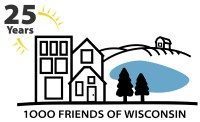Letter to Governor Evers Task Force on Climate Change: eliminate greenhouse gas emissions from the transportation sector
CC: Governor’s Task Force on Climate Change
Dear Lieutenant Governor Barnes,
The undersigned organizations greatly appreciate your administration’s ongoing commitment to taking Wisconsin carbon-neutral by 2050. As you know, Wisconsin’s transportation system is the second greatest emitter of carbon emissions in the state.¹
We urge the Governor’s Task Force on Climate Change to propose ambitious goals and recommendations to rapidly and equitably eliminate greenhouse gas emissions from the transportation sector.
The suggested priorities below would help achieve this objective, while also benefiting public health and quality of life in Wisconsin.
 Electric vehicle (EV) recommendation:
Electric vehicle (EV) recommendation:
- Goal: All new passenger vehicles sales will be electric by 2040, and all new light-duty state fleet vehicles will be electric by 2035.
- Impact: If just half of vehicle miles traveled were electric, Wisconsin’s overall emissions would be reduced by 4,183,638 metric tons per year, or about 4 percent.²
- Recommendation: Facilitate an open marketplace that encourages EV purchases.
Public transit recommendation:
- Goal: Double mass transit use by 2030, to reduce reliance on personal car travel — the top source of transportation emissions.
- Impact: Even modestly expanding public transit service could reduce emissions by 0.9 to 3.6 percent by 2050, while offering significant benefits to social equity.³
- Recommendation: Increase funding for Wisconsin’s public transit systems by at least $50M per year through the state budget to help meet current and future needs.
Active transportation (pedestrian and bicycle) recommendation:
- Goal: Double the number of walking and biking trips taken by 2030, to reduce reliance on personal car travel — the top source of transportation emissions.
- Impact: Improving walking and biking infrastructure in Wisconsin communities could reduce emissions by 0.4 to 1.1 percent by 2050, while offering significant benefits to social equity.4
- Recommendation: Increase state funding for the Transportation Alternatives Program (TAP) by $10 million/biennium.

We would be happy to answer any questions, or provide more detailed policy suggestions. These bold recommendations to reduce transportation emissions will be critical if Wisconsin is to meet its climate goals. We encourage the Task Force on Climate Change to pursue these equitable strategies to clean up our transportation system and enhance the quality of life for all Wisconsinites.
Sincerely,
1000 Friends of Wisconsin
RENEW Wisconsin
WISPIRG (Wisconsin Public Interest Research Group)
Wisconsin Health Professionals for Climate Action
Wisconsin Environmental Health Network (WEHN)
Physicians for Social Responsibility Wisconsin (PSR WI)
Sierra Club – John Muir Chapter
Wisconsin Environment
Waukesha County Green Team
Citizen’s Climate Lobby Rib Mountain – Marshfield Chapter
Lutheran Office for Public Policy in Wisconsin
Interfaith Earth Network of Southeastern Wisconsin
Wisconsin Interfaith Power & Light
North Central Area Congregations Organized to Make an Impact (NAOMI)
Law Office of Dennis M. Grzezinski
Chippewa Valley Transit Alliance
Bike Chippewa Valley
Contact:
Gregg May, Transportation Policy Analyst, 1000 Friends of Wisconsin, gregg@1kfriends.org and
(402) 707-7379
Jane McCurry, Electric Vehicles Program Manager, RENEW Wisconsin, jane@renewwisconsin.org and (234) 380-3177
Peter Skopec, Director, Wisconsin Public Interest Research Group (WISPIRG), peter@wispirg.org and (847) 687-7229
1. U.S. Energy Information Agency, “State Profile and Energy Estimates, Wisconsin Profile, 2017” (webpage). Accessed on 11/15/2019 at https://www.eia.gov/state/?sid=WI#tabs-2.
2. Based on Wisconsin Dept. of Transportation vehicle registration and travel data, U.S. Environmental Protection Agency vehicle emission estimates, and Union of Concerned Scientists “How Clean is Your Electric Vehicle?” calculator.
3. Alana Miller and Tony Dutzik, Frontier Group, Ashwat Narayanan, 1000 Friends of Wisconsin, and Peter Skopec, WISPIRG Foundation, The Road to Clean Transportation: A Bold, Broad Strategy to Cut Pollution and Reduce Carbon Emissions in the Midwest, 2018.
4. Ibid.
